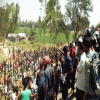Six valuable minerals found in Brahmaputra river

The sands of the Brahmaputra river has been found to contain six types of mineral resources, according to scientists of the Institute of Mining, Mineralogy and Metallurgy (IMMM) in Joypurhat.
Their discovery comes nearly five years after the collection of 2,500 tonnes of sand from different chars in Kurigram and Gaibandha to ascertain the presence of mineral resources that can be used in research and development projects.
The IMMM estimates that about Tk 3,630 crore worth of mineral resources, namely rutile, magnetite, garnet ilmenite, quartz and zircon, can be found in each square kilometre of the Brahmaputra river.
This estimation is based on how each tonne of sand yielded 200 grams of rutile, 400 grams of zircon, 2 kilogrammes (kgs) of ilmenite, 12 kgs of garnet, 50 kgs of quartz and 3.8 kgs of magnetite.
Rutile, which is used in making medicine, steel rods, paint, plastic, ink, cosmetics and welding, is mainly exported by India, Italy, Australia, Sri Lanka, Thailand, South Africa and the US.
Magnetite has uses in cleaning mined coal, producing magnets and steel as well as drilling deep wells for oil and gas exploration, with the two exporting countries being South Africa and Australia.
Meanwhile, India and Australia are the main exporters of garnet, which is used for cleaning iron pipes, producing serrated paper and sand blasting.
Zircon is used in refactories, molding sand and to manufacture ceramics. Australia, South Africa, India, China, Brazil, and the US are the biggest exporters of this mineral.
Ilmenite is the most important ore of titanium and is the main source of titanium dioxide, which is used in paints, inks, fabrics, plastics, paper, sunscreen, food and cosmetics.
It also has high magnetic properties, making it useful for some industrial applications.
Lastly, quartz is a hard, crystalline mineral composed of silica and is the main ingredient for making glass. It also has uses in the refactory, petroleum and jewellery industries.
Dr Mohammad Nazim Jaman, former director of the IMMM, said they conducted a geophysical survey on the chars of the Brahmaputra river in Kurigram and Gaibandha to find whether there are mineral resources in the sand.
"A mineral research institute was established in Joypurhat in 2017 and in 2018, sand collected from the Brahmaputra river were researched and valuable minerals were found," he added.
Jaman informed that the market value of minerals excavated from the sand collected at a depth of 10 metres from each square kilometre is Tk 3,630 crore.
"At present, the sand is extracted and used for construction works," he said.
Abdullah Al Mamun, executive engineer of the Water Development Board in Kurigram, said the Brahmaputra river originates from Manas lake near the Kailas peak of the Himalayas.
The river then flows through Tibet and Assam in India before entering Bangladesh through Kurigram.
During monsoon season, the flow of water is high but later decreases during the dry season, when vast chars emerge from the river.
There are about 400 chars along the Brahmaputra river in Kurigram, Mamun added.
Majnu Mandal, a sand trader at Ashtamir Char in Chilmari upazila of Kurigram, said they extract sand from the Brahmaputra river and sell it for use in construction.
He added that they did not know the river sand contained such valuable minerals until IMMM scientists came to study it a few years ago.
Nahid Hasan, former president of the Rail-River, Communications and Environment Development People's Committee in Chilmari upazila, demanded that the government take quick steps to excavate the mineral resources.

 For all latest news, follow The Daily Star's Google News channel.
For all latest news, follow The Daily Star's Google News channel. 







Comments